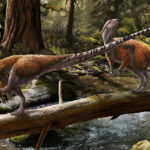2023-09-13 バース大学
◆研究者は、DNA配列の変異から構築された進化ツリーを分析し、複雑な統計的手法を用いて地質学的な時間にわたる絶滅率を推定しました。化石記録には多くの種の消失が示されていますが、これらの種が属する系統、すなわち科や目などが生き残り、今日約40万種の植物のうち約30万種が花を咲かせる植物です。花を咲かせる植物は、適応能力に優れており、さまざまな種の種子散布や受粉メカニズムを使用し、ゲノム全体を複製する種もあれば、光合成の新しい方法を進化させた種もいます。この適応力が、彼らを自然の生き残りとさせた要因とされています。
<関連情報>
- https://www.bath.ac.uk/announcements/natures-great-survivors-flowering-plants-survived-the-mass-extinction-that-killed-the-dinosaurs/
- https://royalsocietypublishing.org/doi/10.1098/rsbl.2023.0314
白亜紀-古第三紀(K-Pg)境界における被子植物の大量絶滅を示す系統学的証拠はない。 No phylogenetic evidence for angiosperm mass extinction at the Cretaceous–Palaeogene (K-Pg) boundary
Biology Letters Published:13 September 2023
DOI:https://doi.org/10.1098/rsbl.2023.0314

Abstract
The Cretaceous–Palaeogene mass extinction event (K-Pg) witnessed upwards of 75% of animal species going extinct, most notably among these are the non-avian dinosaurs. A major question in macroevolution is whether this extinction event influenced the rise of flowering plants (angiosperms). The fossil record suggests that the K-Pg event had a strong regional impact on angiosperms with up to 75% species extinctions, but only had a minor impact on the extinction rates of major lineages (families and orders). Phylogenetic evidence for angiosperm extinction dynamics through time remains unexplored. By analysing two angiosperm mega-phylogenies containing approximately 32 000–73 000 extant species, here we show relatively constant extinction rates throughout geological time and no evidence for a mass extinction at the K-Pg boundary. Despite high species-level extinction observed in the fossil record, our results support the macroevolutionary resilience of angiosperms to the K-Pg mass extinction event via survival of higher lineages.


